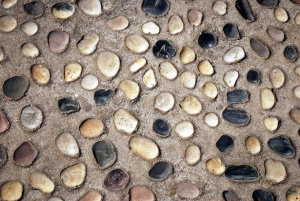Tile alternatives
Broken tiles
Broken tilework was popularised by Gaudi, and is known as pique assiette or trencadis. Broken tiles cost next to nothing.
Broken tiles can also be broken up and treated like mosaic pieces. To break them, wrap in cloth and hammer on the back of the tile. Mosaic pieces offer plenty of artistic possibilities, or can be something as simple as a 2 tone colour mix. Mosaic is very slow to lay though.
Examples:
Broken kitchenware
Pebble tiling
Pebbles make novel tiles, and can be stylish, but the resulting surface is harder to clean due to the uneven surface and a relatively high percentage of exposed grout.
Pretty colour mixes or patterns can be laid. The tiling is quite a bit thicker than ceramic tiles, unless tiny pebbles are used, which are slower to lay.
Cement adhesive
Most tile adhesives and grouts contain methyl cellulose (wallpaper paste) and white cement. Before these were available the use of sand & cement was standard, and of course it can still be used for economy. Its strong & waterproof, but you don't get a lot of time in which to lay the tiles, and a poor mix can let placed tiles slip. For mosaics & pebbles, white cement can act as adhesive & grout. The ceramic tiles should be presoaked overnight to avoid sucking the cement dry prematurely, which would cause cement failure. Adding wallpaper adhesive reduces slip.
Unmodified cement takes a few days to establish any significant strength, accelerator can be used.
Terrazzo
Grinding & polishing concrete with white stone chips pressed into the top surface gives terrazzo. The result is beautiful. Marble and quartz are the main stones used in terrazzo.
Terrazzo is labour intensive to lay, and requires careful choice & use of cleaners to avoid permanent staining.


